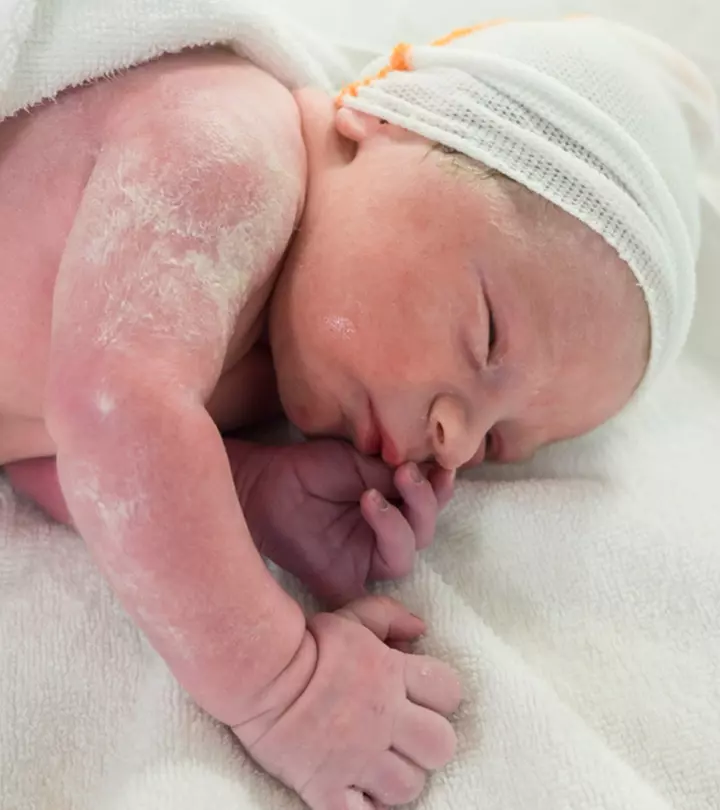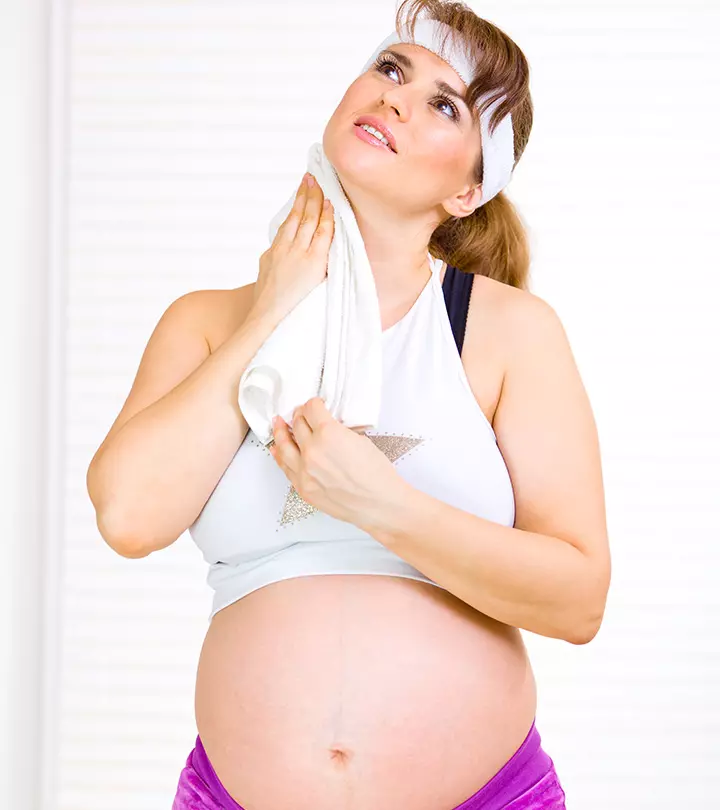
Image: Shutterstock
Vernix caseosa, often known as vernix, is a white, waxy, creamy, or cheesy material that coats the skin of newborns. Vernix comprises the sebaceous gland and periderm cells (which cover the developing skin cells) that are shed around the 21st week of pregnancy. It acts as a fetal membrane by protecting the fetus during development as well as after birth.
Vernix may not be present on the skin of extremely premature newborns or those with very low birth weight. Further, babies born between 32 and 37 weeks of pregnancy may have more vernix than full-term neonates.
Read this article to learn about the benefits and risks of leaving vernix caseosa on a baby’s skin after delivery.
Key Pointers
- Vernix caseosa has natural antimicrobial and antioxidant properties to protect a baby’s skin.
- You can delay the baby’s first bath as keeping the vernix intact on the baby’s skin after delivery is recommended.
- Too much vernix on the baby’s skin might induce newborn aspiration syndrome.
Purpose Of The Vernix Caseosa

Image: Shutterstock
Babies can benefit from vernix caseosa during and after pregnancy. These benefits include the following (1).
- Antimicrobial properties of vernix caseosa help the baby avoid infections that they may contract through the skin during and after delivery
- Waterproofs the fetal skin from the fluid in the womb
- Lubricates the birth canal to reduce friction during vaginal delivery
- Regulates body temperature of newborns
- Moisturizes the skin and prevents baby’s dry skin and cracking
- Enhances the healing of skin wounds, if any, at birth
- Provides the newborn’s skin with antioxidant properties
Besides these benefits, vernix also has certain clinical significance. It may help doctors diagnose uterine rupture, amniotic fluidiThe clear liquid surrounding the fetus in the womb for its protection and healthy growth. embolism, and determine the exposure of drugs in pregnant women.
 Quick fact
Quick factVernix caseosa is a natural protector of a baby’s skin. Allowing it to remain on the baby’s skin for a longer time, that is, delaying the first bath, may reduce the need for various protective baby skincare products, such as moisturizers, creams, and other protective lotions for newborns.
How Long Should The Vernix Stay On A Baby’s Skin?
WHO recommends leaving the vernix intact on the skin after birth.
The beneficial effects of vernix are only obtained if allowed to stay on the baby’s skin for a few hours after birth.
Recent evidence suggests that wiping off vernix for hygiene purposes, drying, or stimulating the respiratory effects may not be necessary for all babies.
Should You Delay Your Baby’s First Bath?

Image: Shutterstock
Delaying the first bath may help the baby reap all the benefits of vernix caseosa (2). There is no recommended time to give a bath to obtain complete benefits. However, delaying the first bath for a few hours could be beneficial.
Some mothers may not give baths to their baby for a few days to a week after birth. It is not necessary to delay bathing for several days. It is essential to remove amniotic fluid and blood from babies’ skin for hygiene purposes. You may ask the hospital staff to gently clean the baby, leaving some of the vernix on their skin. You may massage the vernix into the baby’s skin for a few days after birth.
 Experts say
Experts sayDelaying the first bath may not be ideal for babies born with meconium- (first stool) contaminated amniotic fluid from the amniotic sac or with the risk of contracting infections from the birth canal. You may discuss with the healthcare provider to know the best time and method to bathe your baby.
Risks of Leaving Vernix On A Baby’s Skin After Birth

Image: Shutterstock
Leaving vernix on a newborn’s skin may not pose any risk in most cases. Babies with meconium staining or a history of chorioamnionitis may have an increased risk of developing bacterial overgrowth if the vernix is left on the skin for several hours. In some cases, leaving vernix may increase the risk of the baby contracting maternal infections, such as hepatitis and HIV.
Excess vernix on the baby’s skin may result in neonatal aspiration syndromeiA condition where the baby breathes in its stool and amniotic fluid shortly after or during birth. . In rare cases, vernix caseosa may lead to granulomaiA swollen cluster of white blood cells or other tissues that can be seen in the head, lungs, skin, or other body parts. and peritonitis, fetal heart infection in babies born through C-sections (1). The risk may vary depending on the existing health conditions, so you may take the appropriate decision according to the risks and benefits of leaving vernix on the baby’s skin.
Frequently Asked Questions
1. Does vernix make the baby cold?
No, the vernix caseosa helps keep the baby warm and reduces their risk of contracting conditions such as jaundice and experiencing weight loss (3).
2. Why did my baby have so much vernix?
The amount of vernix on preterm and late preterm babies is often different. Very little or no vernix is found on preterm babies because vernix develops in the latter part of the pregnancy. On the other hand, late preterm babies are covered in more vernix because they do not get the chance to shed in the uterus before the delivery (4).
3.What are the components of Vernix Caseosa?
The vernix caseosa is composed mainly of water (80%), lipids (10.3%), and proteins (9.1%). According to experts, water in vernix caseosa hydrates the skin, whereas proteins and lipids contribute to its moisturizing and protective properties. Vernix caseosa also contains immuno-peptides and enzymes that help maintain skin flora (7).
4. Can vernix caseosa be harmful?
Vernix caseosa is generally not harmful. It acts as a natural barrier for the baby’s skin, protecting it from dryness and preventing infection. In most cases, it is safe to leave it on for a while after birth. However, consult your child’s pediatrician if you notice any signs of skin irritation or infection, or have concerns about the amount of vernix on your baby’s skin. Seeking prompt medical advice can help address any potential issues (1).
Vernix caseosa is a naturally protective layer on a newborn’s skin. Usually, immediate bathing is not required for all babies, and if there are no such factors to delay the first bath, you may wait several hours to let your baby benefit from the vernix and soak its moisture. However, you must discuss it in detail with a healthcare professional to know about all the risks and benefits of leaving the vernix caseosa on your baby’s skin for a longer period.
Infographic: What Purpose Does Vernix Caseosa Serve?
A newborn is covered in a waxy, creamy layer called vernix caseosa, which protects the fetus during developmental stages in the mother’s womb. However, this layer also benefits the baby during and after birth. Check out the infographic to learn about the benefits of vernix caseosa for newborns.
Some thing wrong with infographic shortcode. please verify shortcode syntaxReferences
1. Unraveling the mystery of vernix caseosa; US National Library of Medicine
2. Delayed Bathing; International Childbirth Education Association (ICEA)
3. Newborn care in the delivery room; March of Dimes
4. Differences Between Term and Preterm Newborns; Lancaster General Health
5. Gurcharan Singh and G Archana; Unraveling The Mystery Of Vernix Caseosa; Indian Journal of Dermatology
6. How often should you bathe your baby, from birth through early childhood?; The University of Texas Southwestern Medical Center
7. Vernix Caseosa; US National Library of Medicine
Community Experiences
Join the conversation and become a part of our nurturing community! Share your stories, experiences, and insights to connect with fellow parents.
Read full bio of Dr. Elna Gibson
Read full bio of Dr Bisny T. Joseph
Read full bio of Rohit Garoo
Read full bio of Shinta Liz Sunny
















